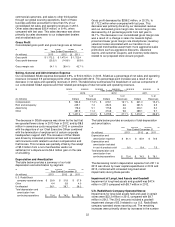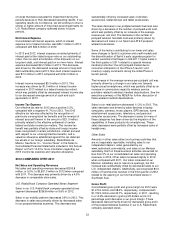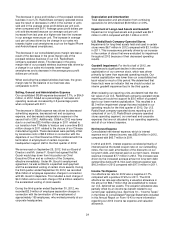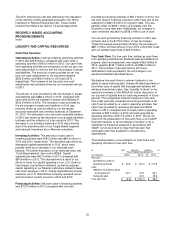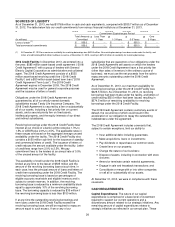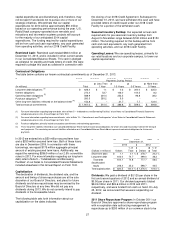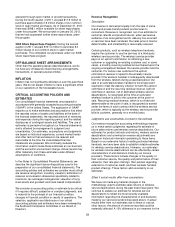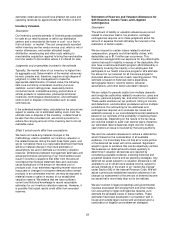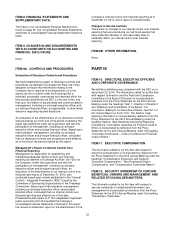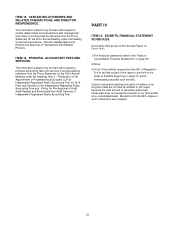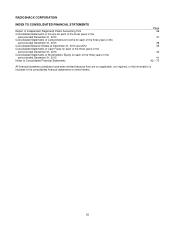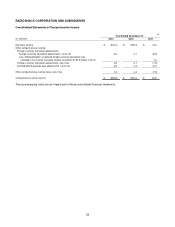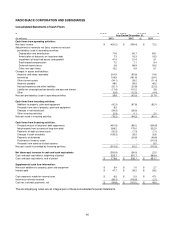Radio Shack 2013 Annual Report Download - page 33
Download and view the complete annual report
Please find page 33 of the 2013 Radio Shack annual report below. You can navigate through the pages in the report by either clicking on the pages listed below, or by using the keyword search tool below to find specific information within the annual report.31
delayed to future years. The result of these actions was a
significant reduction in sales and gross profits in our multi-
year projection which was the primary factor in the
calculation that determined the fair value of the goodwill of
the Mexican subsidiary was less than the carrying amount
in step 1 of the two-step impairment test. In step 2, the fair
value was allocated to assets and liabilities to determine
the implied fair value of the goodwill. The result of this
process calculated the implied fair value of the goodwill of
the Mexican subsidiary to be less than the carrying value
and an impairment charge was recorded.
Stock-Based Compensation
Description
We have historically granted certain stock-based awards to
employees and directors in the form of non-qualified stock
options, incentive stock options, restricted stock and
deferred stock units. See Note 2 - “Summary of Significant
Accounting Policies” and Note 8 - “Stock-Based Incentive
Plans” in the Notes to Consolidated Financial Statements
included elsewhere in this Annual Report on Form 10-K for a
more complete discussion of our stock-based
compensation programs.
At the date an award is granted, we determine the fair value
of the award and recognize the compensation expense
over the requisite service period, which typically is the
period over which the award vests. The restricted stock and
deferred stock units are valued at the fair market value of
our stock on the date of grant. The fair value of stock
options with only service conditions is estimated using the
Black-Scholes-Merton option-pricing model. The fair value
of stock options with service and market conditions is
valued utilizing a binomial lattice model with Monte Carlo
simulations.
Judgments and uncertainties involved in the estimate
The Black-Scholes-Merton and lattice models require
management to apply judgment and use subjective
assumptions, including expected option life, volatility of
stock prices, and employee forfeiture rate. We use
historical data and judgment to estimate the expected
option life and employee forfeiture rate, and use historical
and implied volatility when estimating the stock price
volatility. Changes in these assumptions can materially
affect the fair value estimate.
Effect if actual results differ from assumptions
We have not made any material changes in the accounting
methodologies used to record stock-based compensation
during the past three years. While the assumptions that we
develop are based on our best expectations, they involve
inherent uncertainties based on market conditions and
employee behavior that are outside of our control. If actual
results are not consistent with the assumptions used, the
stock-based compensation expense reported in our
financial statements may not be representative of the actual
economic cost of the stock-based compensation.
Additionally, if actual employee forfeitures significantly differ
from our estimated forfeitures, we may have an adjustment
to our financial statements in future periods. A 10% change
in our stock-based compensation expense in 2013 would
have affected our net income by approximately $0.7 million.
FACTORS THAT MAY AFFECT FUTURE RESULTS
Matters discussed in our MD&A and in other parts of this
Annual Report on Form 10-K include forward-looking
statements within the meaning of the federal securities
laws, including Section 27A of the Securities Act of 1933,
as amended, and Section 21E of the Exchange Act. These
forward-looking statements are statements that are not
historical and may be identified by the use of words such as
“expect,” “believe,” “anticipate,” “estimate,” “intend,”
“potential” or similar words. These matters include
statements concerning management’s plans and objectives
relating to our operations or economic performance and
related assumptions. We specifically disclaim any duty to
update any of the information set forth in this report,
including any forward-looking statements. Forward-looking
statements are made based on management’s current
expectations and beliefs concerning future events and,
therefore, involve a number of assumptions, risks and
uncertainties, including the risk factors described in Item
1A, “Risk Factors,” of this Annual Report on Form 10-K.
Management cautions that forward-looking statements are
not guarantees, and our actual results could differ
materially from those expressed or implied in the forward-
looking statements.
ITEM 7A. QUANTITATIVE AND QUALITATIVE
DISCLOSURES ABOUT MARKET RISK.
At December 31, 2013, we held no derivative instruments
that materially increased our exposure to market risks for
interest rates, foreign currency rates, commodity prices or
other market price risks.
Our exposure to interest rate risk results from changes in
short-term interest rates. Interest rate risk exists with
respect to our cash equivalents of $124.4 million and our
$300 million of term loans that bear interest at variable
rates, in each case at December 31, 2013. A hypothetical
1% increase in short-term interest rates would result in a
corresponding increase in annual net interest expense of
approximately $1.3 million. Short-term liquid investments at
variable interest rates currently yield less than 1% on an
annualized basis. A hypothetical decrease of short-term
interest rates to zero would result in virtually no
corresponding change in annual net interest expense. This
hypothetical example assumes no change in the
proportionate relationship between our cash equivalent
balance and the amount of our variable interest rate debt.
We have market risk arising from changes in foreign
currency exchange rates related to our purchase of
inventory from manufacturers located in China and other
areas outside the U.S. Our purchases are denominated in
U.S. dollars, and any weakening of the U.S. dollar against
the Chinese currency, or other currencies, could cause our
vendors to increase the prices of items we purchase from
them. It is not possible to estimate the effect of foreign
currency exchange rate changes on our purchases of this
inventory. We are also exposed to foreign currency
fluctuations related to our Mexican subsidiary, which
accounted for less than 5% of our consolidated net sales
and operating revenues in 2013.



